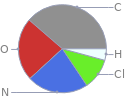Input interpretation

2-chloroadenosine hemihydrate | elemental composition
Result

Find the elemental composition for 2-chloroadenosine hemihydrate in terms of the atom and mass percents: atom percent = N_i/N_atoms × 100% mass percent = (N_im_i)/m × 100% Plan: • Write the chemical formula and gather atomic masses from the periodic table. • Determine values for N_i, m_i, N_atoms and m using these items. • Finally, compute the percents and check the results. Write the chemical formula: C_10H_12ClN_5O_4·0.5H_2O Use the chemical formula, C_10H_12ClN_5O_4·0.5H_2O, to count the number of atoms, N_i, for each element and find the total number of atoms, N_atoms: | number of atoms C (carbon) | 20 Cl (chlorine) | 2 H (hydrogen) | 26 N (nitrogen) | 10 O (oxygen) | 9 N_atoms = 20 + 2 + 26 + 10 + 9 = 67 Divide each N_i by N_atoms to calculate atom fractions. Then use the property that atom fractions must sum to one to check the work: | number of atoms | atom fraction C (carbon) | 20 | 20/67 Cl (chlorine) | 2 | 2/67 H (hydrogen) | 26 | 26/67 N (nitrogen) | 10 | 10/67 O (oxygen) | 9 | 9/67 Check: 20/67 + 2/67 + 26/67 + 10/67 + 9/67 = 1 Compute atom percents using the atom fractions: | number of atoms | atom percent C (carbon) | 20 | 20/67 × 100% = 29.9% Cl (chlorine) | 2 | 2/67 × 100% = 2.99% H (hydrogen) | 26 | 26/67 × 100% = 38.8% N (nitrogen) | 10 | 10/67 × 100% = 14.9% O (oxygen) | 9 | 9/67 × 100% = 13.4% Look up the atomic mass, m_i, in unified atomic mass units, u, for each element in the periodic table: | number of atoms | atom percent | atomic mass/u C (carbon) | 20 | 29.9% | 12.011 Cl (chlorine) | 2 | 2.99% | 35.45 H (hydrogen) | 26 | 38.8% | 1.008 N (nitrogen) | 10 | 14.9% | 14.007 O (oxygen) | 9 | 13.4% | 15.999 Multiply N_i by m_i to compute the mass for each element. Then sum those values to compute the molecular mass, m: | number of atoms | atom percent | atomic mass/u | mass/u C (carbon) | 20 | 29.9% | 12.011 | 20 × 12.011 = 240.220 Cl (chlorine) | 2 | 2.99% | 35.45 | 2 × 35.45 = 70.90 H (hydrogen) | 26 | 38.8% | 1.008 | 26 × 1.008 = 26.208 N (nitrogen) | 10 | 14.9% | 14.007 | 10 × 14.007 = 140.070 O (oxygen) | 9 | 13.4% | 15.999 | 9 × 15.999 = 143.991 m = 240.220 u + 70.90 u + 26.208 u + 140.070 u + 143.991 u = 621.389 u Divide the mass for each element by m to calculate mass fractions. Then use the property that mass fractions must sum to one to check the work: | number of atoms | atom percent | mass fraction C (carbon) | 20 | 29.9% | 240.220/621.389 Cl (chlorine) | 2 | 2.99% | 70.90/621.389 H (hydrogen) | 26 | 38.8% | 26.208/621.389 N (nitrogen) | 10 | 14.9% | 140.070/621.389 O (oxygen) | 9 | 13.4% | 143.991/621.389 Check: 240.220/621.389 + 70.90/621.389 + 26.208/621.389 + 140.070/621.389 + 143.991/621.389 = 1 Compute mass percents using the mass fractions: Answer: | | | number of atoms | atom percent | mass percent C (carbon) | 20 | 29.9% | 240.220/621.389 × 100% = 38.66% Cl (chlorine) | 2 | 2.99% | 70.90/621.389 × 100% = 11.41% H (hydrogen) | 26 | 38.8% | 26.208/621.389 × 100% = 4.218% N (nitrogen) | 10 | 14.9% | 140.070/621.389 × 100% = 22.54% O (oxygen) | 9 | 13.4% | 143.991/621.389 × 100% = 23.17%
Mass fraction pie chart

Mass fraction pie chart